Are you currently trying to improve your swimming in readiness for the 2018 triathlon season?
You are not alone.
There are two ways to do this.
- Get fitter – Swim more (increase frequency and or volume), or swim harder (CSS and Vo2 max intervals). Some people even try swimming more and harder but that’s generally not advised.
- Become more efficient – This means working on technique and body position to reduce drag and move further with each stroke.
Which do you think is the more popular option?
If you chose #1 then you would be right, but in reality both methods work.
However, if you are constantly focussing on improving your CSS time (defined as the pace you would swim 1500m and displayed as pace per 100m), or reducing your 400m TT time by just working on your fitness, then you will eventually reach a plateau. Your progress will slow to a very frustrating level where you seem to only gain a few seconds each year. At this point, it will be your poor technique and body position holding you back.
Don’t get me wrong. Plenty of swimmers are working on #2 but maybe not as much as they should be, and on the wrong things. For example they work on a better catch by employing Early Vertical Forearm (EVF), getting more glide at the front end to reduce stroke count, or on developing a high elbow recovery using drills like trail fingers.
Novice swimmers can make quick gains in performance, but then so can newcomers to just about anything. That’s why research studies on untrained subjects testing, for example, short duration high/intensity intervals for 5 minutes per week show great results.
For those who have been “in the game” for a bit longer, the results are harder to come by.
Dropping your CSS/100m time by even 2-3 seconds can take several months of very hard work.
Regularly completing big sets of intervals is tiring especially when you are a triathlete with hard work to do on the bike or run. The total load for a full week of training can lead to excessive fatigue, and unless matched by additional rest can actually have a negative impact on training.
There is an alternative approach.
Please don’t misinterpret this as a stand against interval work. You must still do this, but maybe not in the same quantities.
You can make just as much progress, maybe more, by focussing on becoming more efficient in the water (option 2 from my original statement).
The ratio of intervals to aerobic conditioning and technique work will fall into the 80:20 category employed in Polarised training.
For example, if you swim 3 times per week and average 2500m per session, that’s a weekly total of 7500m.
80% = 6000m, with 20% (1500m) left for intervals.
You could do this as 1 conditioning block of 1500m in one session (this might be your “key” session in the pool each week), or you could include 500m of intervals at the end of each session. I don’t know if either is better so you might want to experiment and work out which is best for you.
Now you have 6000m per week to use and your next question is, “How do I do that, Simon?”
Right at the beginning I mentioned the idea that body position, and therefore drag, was holding you back.
Imagine a Ferrari towing a large parachute. The chute will create drag and this will prevent the car from ever reaching its top speed. Remove the chute and the car performs as expected.
Most triathletes already have the engine power, but in the pool they have the equivalent of a parachute slowing them down. (In fact if you really want to prove this argument, create more drag by wearing a band around your ankles, wearing drag shorts, or swimming in a baggy cotton T shirt).
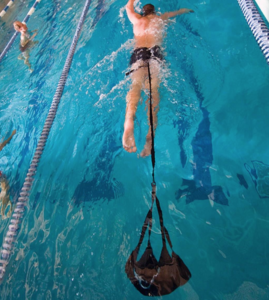
Imagine the drag caused by this bit of kit!
If you can identify and correct the issues that are causing the drag then you could swim at the same speed for less effort (a goal worth pursuing for long distance triathletes), or with the same effort, swim faster but without having to improve fitness.
You may also find that your swim times improve much quicker than if you employed the interval training approach.
The logic of this is that it removes the “struggle and suffer” approach employed by many athletes and promoted by some coaches.
Below are some of the areas where drag is commonly created and some ideas on how to focus on this
Areas that cause drag and how to correct them
- Tight hip flexors causing low leg position – Work on hip flexor mobility, every day. This simple stretch is good enough
- Ankles with poor mobility that point down instead of back – Work on ankle flexion and mobility every day (see photo below – a folded towel behind the knees might help with this to begin with)
- Breath holding causing high chest & low hips – The Bubble, Bubble, Breathe drill from Swim Smooth is a great one to start with. Learning to breathe at exactly the right time will correct this issue and will also help if you suffer from anxiety in the water (i.e. concentrating on your breathing means you can’t think about your fears!)
- Tight lats leading to shortened stroke – Another dry land exercise you can do every single day (see photo below)
- Poor rotation at shoulders and hips leading to square/flat position in the water – including the kick on side drill and the variations (6-1-6 and 6-3-6) will help this as well as working on your kick and also getting the right hand position for the start of the catch. Triple win!
- Crossing centre line on hand entry or just after which is counter balance by scissor kick – This fault causes a wiggle in the stroke and is often counter balanced by a scissor kick. Catch up stroke with a kick board may help to correct both
- Poor core control allow hips to wiggle – More dry land work to strengthen your core. Try this Bridge Complex which will take no more than 2 minutes. Kicking on side will also help with this.
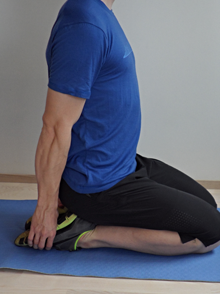
Ankle flexion stretch
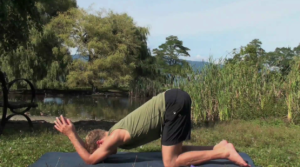
Lat & Tricep stretch
Here’s how your swim programme might look, going forward:
- Maintain swim volume
- Adjust mindset in short term to one of swimming the same time with less effort
- Reduce high intensity work to one key block per week as 15-20% of overall weekly volume, or a small block in each session totalling same amount. For example, assume 3 x 2500m/week (7500m total) options = 1 block of 1500m or 3 x 500m at CSS pace or above
- Add more kicking to create balance and rhythm in stroke
- Add more dry land work to increase mobility in ankles, hips, upper back, shoulders and lats
- Pay a lot of attention to breathing patterns to help with body position and relaxation in water
- If possible increase swim frequency. Keeping the same volume but dividing that up into smaller chunks will help your feel for the water because you will be swimming more regularly, and working on all the other items mentioned above.
Hopefully you can now appreciate where I’m coming from. Focus on efficiency in the water first, with intensity second. In time as your stroke and body position improve, you can add more intensity (although I’m not sure it should ever be more than 20-25% of your total swimming volume), and you may find that you have made more progress than you ever thought possible.
Happy swimming!



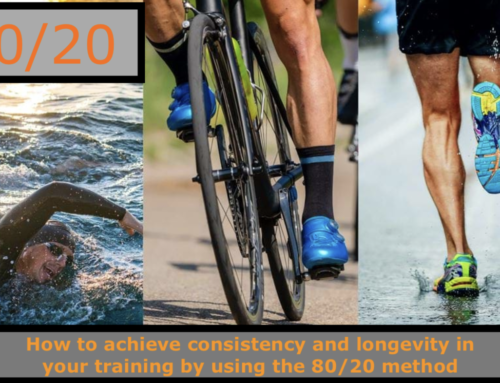

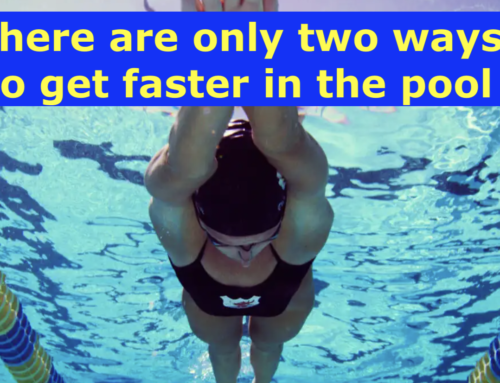
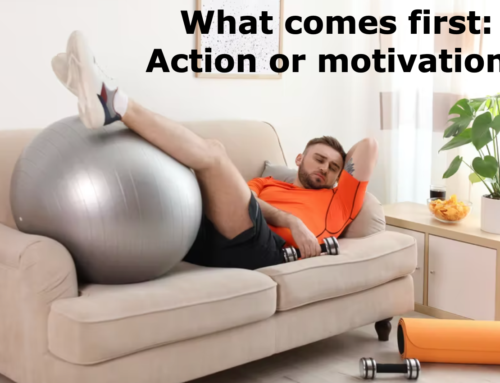
Leave A Comment